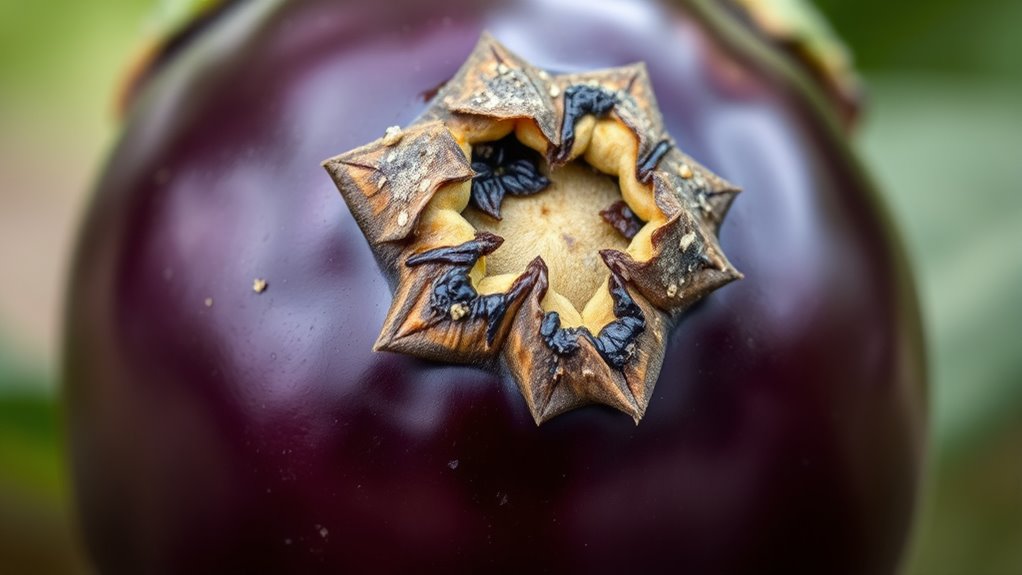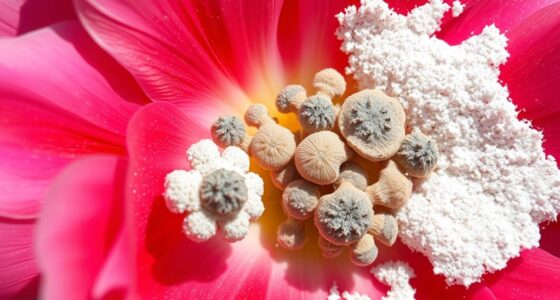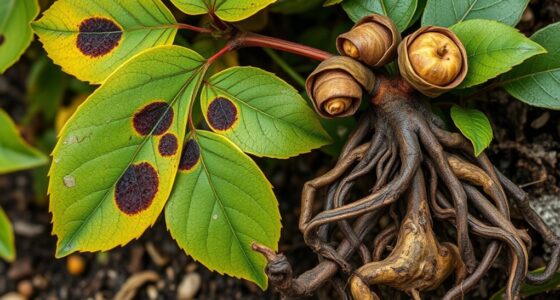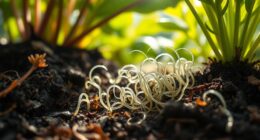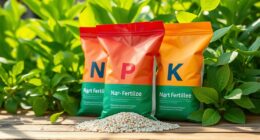When your eggplant turns brown, it could be due to blossom end rot or anthracnose. Blossom end rot shows as soft, wet spots at the bottom with a foul smell, caused by calcium deficiency from inconsistent watering. Anthracnose creates sunken, dark lesions on the surface, spreading through fungal spores in humid conditions. To accurately identify and fix the problem, understanding these signs and causes is essential—keep exploring to find out how to prevent future issues.
Key Takeaways
- Blossom end rot causes soft, water-soaked, sunken brown patches at the eggplant’s blossom end due to calcium deficiency.
- Anthracnose presents as sunken, dark lesions with concentric rings, often in warm, humid conditions.
- Pest damage results in irregular holes or rough patches, while rot is soft, foul-smelling, and water-soaked.
- Proper diagnosis involves examining texture, color, and lesion pattern to differentiate between rot, disease, or pest injury.
- Maintaining consistent watering, soil health, and early disease control can prevent both blossom end rot and anthracnose.
Recognizing the Visible Signs on Eggplants
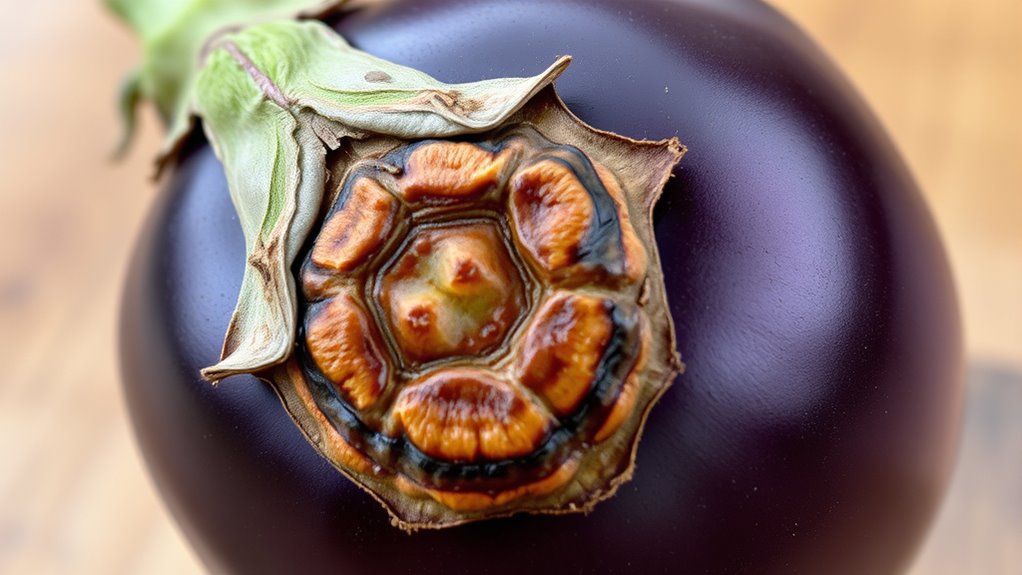
How can you tell if your eggplant is starting to turn brown? Look closely at the fruit’s surface for early signs of discoloration, which often appears as dark, sunken spots. These brown patches can indicate pollination issues, where flowers didn’t produce healthy fruit, or pest damage that compromised the skin’s integrity. Pest damage might include small holes or rough patches, hinting at insects feeding on the surface. Additionally, uneven browning or soft, decayed areas are red flags. The key is to observe the texture and color changes carefully. Recognizing these visible signs early helps you determine whether the browning is due to pollination problems or pests, allowing you to take appropriate action to protect your eggplants. Being aware of pest damage signs can further assist in early detection and prevention. Moreover, understanding plant disease symptoms can help differentiate between various causes of browning and ensure proper treatment. Identifying specific symptoms of common diseases can guide you in selecting effective remedies to save your crop.
Causes and Conditions Behind Blossom End Rot
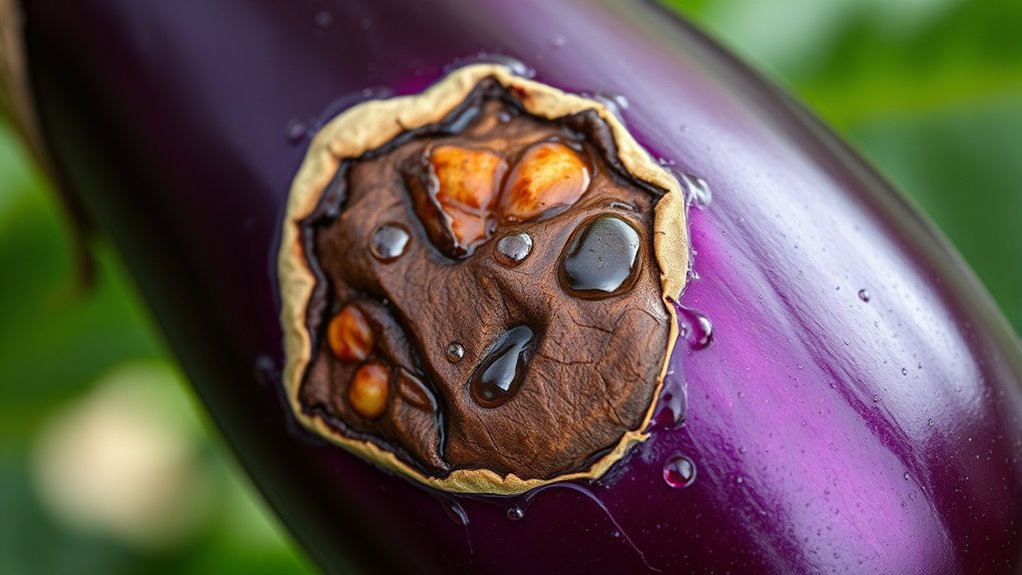
Blossom end rot is primarily caused by a calcium deficiency in the developing fruit, which often results from inconsistent watering or poor soil conditions. To address this, you should focus on maintaining even soil moisture and making soil pH adjustments if needed, since calcium uptake depends on proper pH levels—aim for a soil pH around 6.0 to 6.8. Poor soil drainage or imbalances can hinder calcium absorption, leading to rot. Additionally, pests like aphids or other insects can stress plants and worsen nutrient deficiencies. Implement pest control strategies such as introducing beneficial insects or using organic insecticides to keep pests in check. Proper soil insulation and aeration can also help improve drainage and nutrient availability. Ensuring adequate calcium levels through soil testing can help prevent deficiencies before they affect your plants. Regular monitoring and soil amendments are vital for healthy eggplant development. By managing soil health and controlling pests, you create a better environment for healthy eggplant development, reducing the risk of blossom end rot.
The Development and Spread of Anthracnose
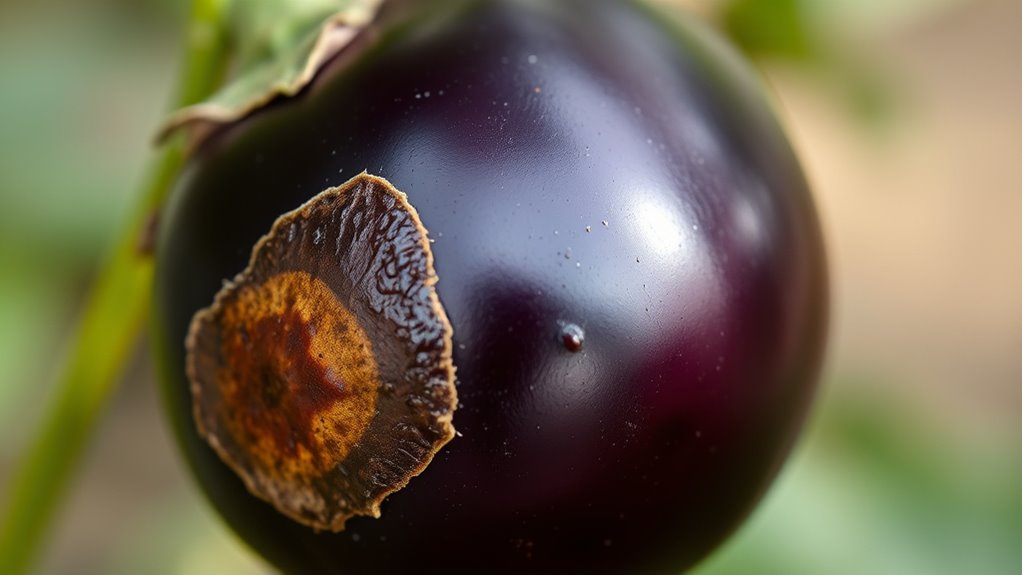
Understanding how anthracnose develops and spreads is key to protecting your eggplants from this destructive disease. The disease is caused by soil fungi that can survive in the soil for years, especially if infected plant debris remains. When conditions are warm and humid, spores from the fungi infect plant tissues, creating dark, sunken lesions. These spores spread through splashing water, wind, and contaminated tools, quickly infecting nearby plants. To minimize this, practicing crop rotation is essential. By rotating eggplants with non-host crops, you reduce soil fungi buildup and interrupt the disease cycle. Proper sanitation, such as cleaning tools and removing infected debris, also slows the spread. Being proactive helps keep your eggplants healthy and reduces the risk of widespread infection.
Differentiating Symptoms: Rot vs. Disease

Distinguishing between rot and disease is essential for effective eggplant management. Rot often appears as soft, water-soaked spots that expand quickly, with a foul smell and a wet texture. It usually affects the fruit’s blossom end and can be caused by inconsistent watering or soil issues. In contrast, disease symptoms like anthracnose present as sunken, dark lesions with concentric rings on the fruit surface, often spreading slowly. Pest infestations may also cause damage, leading to irregular spots or holes. To prevent these problems, proper soil amendments improve plant health and reduce susceptibility. Carefully monitoring your plants helps identify whether browning is due to rot or disease. Correct diagnosis guarantees you apply the right treatment and avoid unnecessary pesticide use, promoting healthier eggplants. Additionally, understanding the symptoms of plant diseases helps in early detection and management. Incorporating preventive measures, such as crop rotation and resistant varieties, can further reduce the risk of both rot and disease. Being aware of cybersecurity threats like hacking incidents can also help safeguard your gardening data and resources.
Preventative Measures for Healthy Eggplants
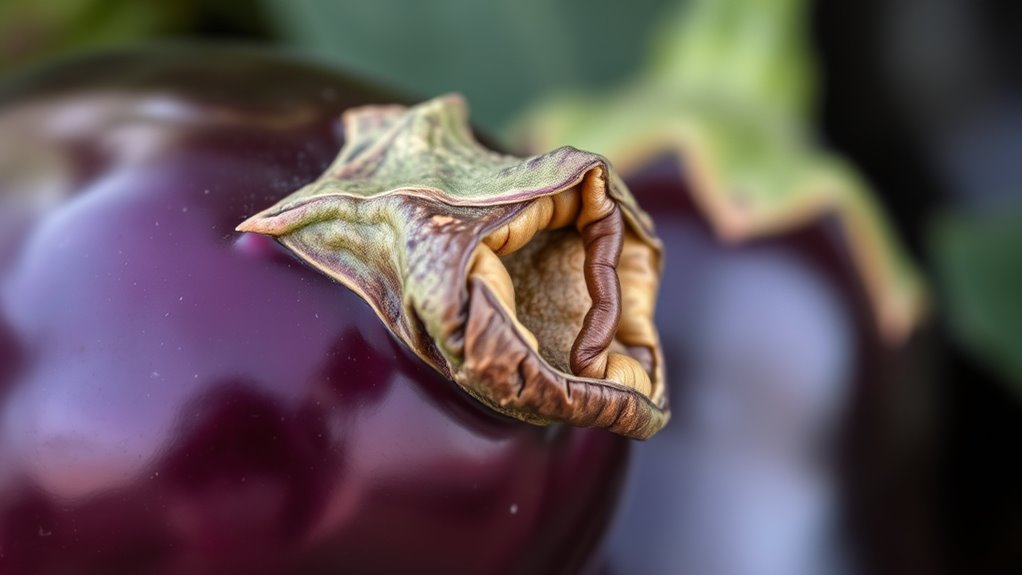
To keep your eggplants healthy, start with consistent watering to prevent stress and disease. Make sure you provide the right nutrients to support growth, and consider choosing disease-resistant varieties for added protection. These simple steps can considerably reduce the risk of browning and other issues. Additionally, employing advanced monitoring tools can help detect early signs of problems, allowing for timely intervention before the issues become severe. Regularly inspecting your plants for signs of spoilage such as off-smell and discoloration can also help catch issues early and maintain overall plant health.
Consistent Watering Practices
Maintaining consistent watering is essential for preventing eggplants from turning brown and ensuring healthy growth. Proper watering consistency helps regulate moisture control, reducing stress that can lead to issues like blossom end rot or disease. To achieve this, water your eggplants deeply and regularly, avoiding both drought and waterlogging. Stick to a routine, especially during hot or dry periods. Here’s a simple guide:
| Watering Frequency | Notes |
|---|---|
| Every 2-3 days | During hot weather |
| Weekly | Cooler months |
| Deep watering | Ensures moisture reaches roots |
| Avoid light watering | Prevents uneven moisture |
| Mulch helps retain moisture | Supports moisture control |
Consistent watering keeps your eggplants healthy, vibrant, and less prone to browning.
Proper Nutrient Management
Have you considered how proper nutrient management can prevent eggplants from turning brown? Ensuring your soil has the right nutrients is essential. Start with soil amendments like compost or organic matter to boost fertility and improve drainage. Regularly test your soil’s pH balance, aiming for a pH of 5.8 to 6.5, which helps plants absorb nutrients effectively. If your soil is too acidic or alkaline, add lime or sulfur accordingly to correct it. Providing balanced fertilization tailored to eggplants’ needs supports healthy growth and reduces stress that can lead to browning or rot. By maintaining ideal soil conditions through amendments and pH management, you create a strong foundation for vibrant, healthy eggplants free from browning issues. Additionally, understanding soil health can help you implement practices that promote nutrient availability and prevent common problems like blossom end rot. Proper nutrient balance also plays a crucial role in preventing deficiencies that cause browning. Maintaining consistent soil testing can help detect nutrient imbalances early and allow for timely corrections.
Disease-Resistant Varieties
Choosing disease-resistant eggplant varieties is one of the most effective ways to prevent common problems like browning and rot. These disease-resistant varieties are bred to withstand common pathogens, reducing your reliance on chemical treatments. Some varieties have been developed through traditional breeding, while others benefit from genetic modification, which enhances their resistance traits more quickly and precisely. By selecting these resilient types, you lower the risk of issues like blossom end rot and anthracnose, ensuring healthier plants and better yields. Incorporating disease-resistant varieties into your garden is a proactive step that promotes plant health and minimizes the need for extensive disease management. Regular monitoring and proper cultural practices can further support the health of your eggplants, making preventative measures even more effective.
Treatment Options for Affected Fruit
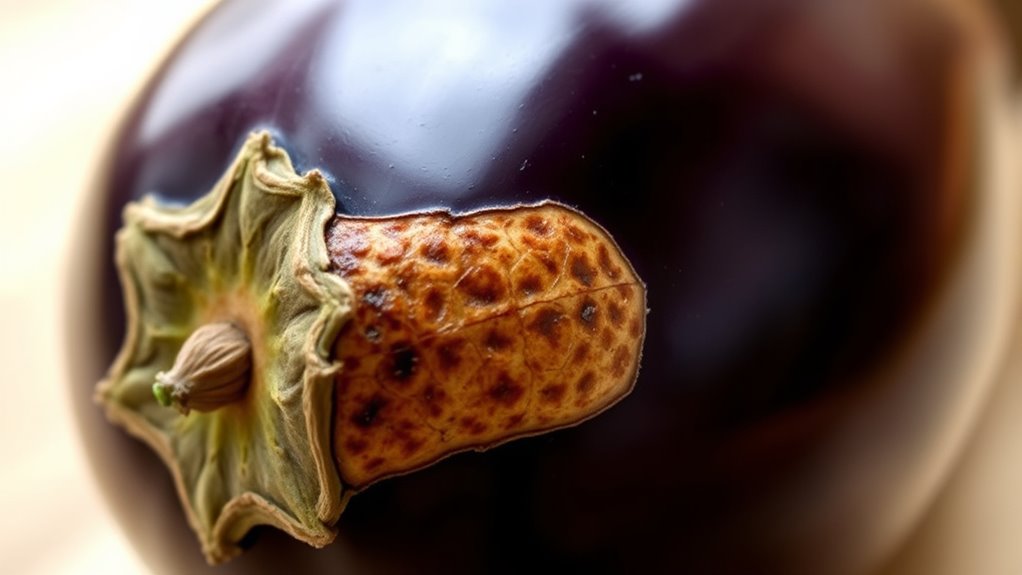
If your eggplants are turning brown, start by removing the affected fruit to prevent the spread of issues. Adjust your watering practices to avoid overwatering or drought stress, which can worsen the problem. You can also apply preventative sprays to protect healthy fruit and reduce future damage.
Remove Affected Fruit
When you notice brown discoloration on your eggplant, removing the affected fruit promptly is essential to prevent the spread of disease and protect your healthy plants. Carefully pick off the damaged fruit, discarding it away from your garden to avoid pest infestations and soil contamination. Leaving affected fruit can attract pests and allow pathogens to spread to nearby plants. Use clean, sterilized tools to prevent transferring any disease. Dispose of the removed fruit in sealed bags or compost it only if you’re sure it’s free of disease. Regularly inspecting your plants helps catch issues early. Removing affected fruit not only reduces the risk of pests but also minimizes the chance of soil contamination, keeping your garden healthier overall. Proper sanitation practices are vital in managing plant health and preventing the spread of infections. Implementing disease prevention strategies, such as crop rotation and resistant varieties, can further protect your eggplants from common issues. Additionally, understanding plant disease symptoms can aid in early detection and effective management.
Adjust Watering Practices
Adjusting your watering practices is a crucial step in managing brown discoloration on your eggplant, as overwatering or underwatering can stress the plant and promote disease. Establish a consistent watering schedule to maintain ideal soil moisture, preventing fluctuations that can cause fruit issues. Check soil moisture regularly—your finger can be a simple tool to gauge when to water. The soil should be moist but not waterlogged; aim for even moisture distribution. Deep, infrequent watering encourages healthy root growth and helps prevent blossom end rot or anthracnose. Avoid letting the soil dry out completely or stay overly wet, which can weaken the plant’s defenses. Proper watering ensures your eggplant remains healthy, reducing stress and minimizing the risk of brown spots. Additionally, understanding watering techniques can further optimize plant health and prevent common issues.
Use Preventative Sprays
Using preventative sprays can be an effective way to protect your eggplant from brown spots and other fungal issues like anthracnose. Choose fungicides labeled for pest control on eggplants and apply them early in the season to build a protective barrier. Regular application helps prevent spores from infecting the fruit. Before spraying, perform soil testing to identify any nutrient imbalances that may weaken your plants’ defenses. Adjust soil conditions accordingly, as healthy soil reduces disease susceptibility. Always follow manufacturer instructions for application frequency and coverage. Combining preventative sprays with good cultural practices, like proper spacing and sanitation, enhances your eggplant’s resistance. This proactive approach minimizes the risk of browning and keeps your harvest healthy and vibrant.
Best Practices for Managing Future Growth

To promote healthy future growth of your eggplants, maintaining regular oversight of their development and making timely adjustments is vital. Start by evaluating your soil and adding appropriate soil amendments, like compost or calcium-rich amendments, to prevent issues such as blossom end rot. Make certain your plants receive consistent watering to avoid stress that can lead to browning. Implement effective pest control measures to keep insects and diseases at bay, which can hinder growth and cause damage. Regularly inspect your plants for early signs of problems and address them promptly. Mulching helps retain moisture and suppress weeds, creating a stable environment for your eggplants. By staying vigilant and adjusting your care routine, you’ll foster strong, healthy plants capable of producing abundant, vibrant fruit.
Frequently Asked Questions
Can Environmental Stress Cause Eggplant Browning Besides Rot and Disease?
Environmental factors and pest damage can definitely cause eggplant browning beyond rot and disease. When you experience irregular watering, extreme temperatures, or poor soil conditions, your eggplants may develop browning or spots. Pest damage, like from aphids or beetles, can also stress plants, leading to browning tissues. Managing these environmental stresses and controlling pests helps keep your eggplants healthy and prevents browning caused by factors other than rot or disease.
Are Certain Eggplant Varieties More Resistant to Blossom End Rot or Anthracnose?
Some eggplant varieties have better resistance to blossom end rot and anthracnose due to cultivar differences. You’ll find that choosing resistant varieties can reduce your risk of browning or disease. Look for cultivars labeled as resistant or tolerant, especially if you’ve had issues in past seasons. Variety resistance depends on genetic traits, so selecting the right cultivar can help you grow healthier plants and minimize problems related to these common issues.
How Does Soil Ph Influence the Development of Blossom End Rot?
Soil pH greatly influences blossom end rot by affecting soil acidity and nutrient availability. If your soil is too acidic or alkaline, calcium uptake becomes limited, increasing the risk of rot. Maintaining a balanced soil pH around 6.0 to 6.8 ensures nutrients, especially calcium, stay available to your eggplants. Regular testing helps you modify soil conditions, preventing blossom end rot caused by calcium deficiency linked to soil pH imbalances.
Can Pruning or Staking Reduce the Risk of Eggplant Browning?
Did you know that proper pruning and staking can reduce eggplant browning by up to 30%? Pruning techniques improve airflow and reduce disease, while staking benefits prevent fruit from touching the soil and tearing. Both practices support healthy growth, minimize stress, and lower the risk of blossom end rot. By using these methods, you give your eggplants a better chance to produce perfect, blemish-free fruit.
What Are the Long-Term Effects of Anthracnose on Plant Yield?
You wonder about anthracnose’s long-term effects on your plant yield. It can cause fruit infections that reduce harvest quality and quantity over time. To minimize these impacts, practice crop rotation and effective disease management, like removing infected plant debris and applying suitable fungicides. By doing so, you help prevent the disease from spreading and protect future yields, ensuring your plants stay healthy and productive in the long run.
Conclusion
If your eggplants are turning brown, identifying whether it’s blossom end rot or anthracnose is key. For example, a gardener noticed brown spots developing on her eggplants and learned it was blossom end rot caused by calcium deficiency. By understanding the signs and applying proper care, you can prevent future issues. Keep an eye on your plants, adjust watering, and practice good sanitation to enjoy healthy, vibrant eggplants all season long.
